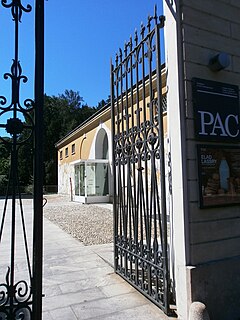
Ugo Nespolo is an Italian painter and sculptor, particularly known for his experimental films, his applied arts works and his artistic collaborations in advertising, theatre and literature.

The Christian Democratic Centre was a Christian-democratic political party in Italy from 1994 to 2002. The CCD was a member of the European People's Party (EPP).
Germano Celant is an Italian art historian, critic and curator who coined the term "Arte Povera" in 1967 and wrote many articles and books on the subject.

An art manifesto is a public declaration of the intentions, motives, or views of an artist or artistic movement. Manifestos are a standard feature of the various movements in the modernist avant-garde and are still written today. Art manifestos are sometimes in their rhetoric intended for shock value, to achieve a revolutionary effect. They often address wider issues, such as the political system. Typical themes are the need for revolution, freedom and the implied or overtly stated superiority of the writers over the status quo. The manifesto gives a means of expressing, publicising and recording ideas for the artist or art group—even if only one or two people write the words, it is mostly still attributed to the group name.
Carel Balth is a Dutch artist and curator.

Spatialism is an art movement founded by Italian artist Lucio Fontana in Milan in 1947 in which he grandiosely intended to synthesize colour, sound, space, movement, and time into a new type of art. The main ideas of the movement were anticipated in his Manifiesto blanco published in Buenos Aires in 1946. In it he spoke of a new "spatial" art in keeping with the spirit of the post-war age. It repudiated the illusory or "virtual" space of traditional easel painting and sought to unite art and science to project colour and form into real space by the use of up-to-date techniques such as neon lighting and television. Five more manifestos followed; they were more specific in their negative than their positive aspects, and carried the concept of Spatialism little further than the statement that its essence consisted in "plastic emotions and emotions of colour projected upon space". In 1947 Fontana created a "Black Spatial Environment", a room painted black, which was considered to have foreshadowed Environment art. His stabbed and slashed canvases are also considered to embody Spatialism. An example of the slashed type is Spatial Concept Waiting. Although Fontana's ideas were vague, his outlook was influential, for he was one of the first, certainly the first European artist to truly promote the idea of art as gesture or performance, rather than as the creation of an enduring physical work.
Henk Peeters was a Dutch artist. He was an active member of the ZERO movement. Peeters was born in The Hague. He studied Fine Art at the Koninklijke Academie voor Beeldende Kunsten in The Hague and taught from 1957 until 1972 at the Art Academy in Arnhem, the Netherlands. Until his death, Henk Peeters restored artworks from the Nul period and remained an active spokesman for the Nul group.
Enrico Castellani was an Italian painter associated with the zero movement and Azimuth. Castellani contributed the development of avant-garde art in Europe in the 1950s and 1960s, and was described as one of Italy's most influential artists of the 20th century,

Heinz Mack is a German artist. Together with Otto Piene he founded the ZERO movement in 1957. He exhibited works at documenta in 1964 and 1977 and he represented Germany at the 1970 Venice Biennale. He is best known for his contributions to op art, light art and kinetic art.
Reformism and Freedom is a "reformist" and mainly social-democratic think tank in Italy. ReL, whose president is Fabrizio Cicchitto, has been associated with The People of Freedom (PdL), a political party, until 2013 and is now close to New Centre-Right (NCD).

Carla Accardi was an Italian abstract painter associated with the Arte Informel and Arte Povera movements and a founding member of the Italian art groups Forma (1947) and Continuità (1961).

Padiglione d'Arte Contemporanea (PAC) is a contemporary art space in Milan, Italy. It is in via Palestro, opposite the Giardini Pubblici Indro Montanelli, next door to the Galleria d'Arte Moderna.
Berengo Studio is one of the glassmaking and glass art companies based in Murano, Venice (Italy).
Arte Informale is a term coined in 1950 by the French critic Michel Tapié to refer to the art movement that began during the mid-1940s in post-World War II Europe. This movement also paralleled the Abstract Expressionism movement that was taking place at the same time in the United States, and had ties to the Arte Povera movement. Sometimes referred to as Tachism, Art Autre or Lyrical Abstraction, it was a type of abstraction in which form became less important than that of the expressive impulses of the artist, and was opposed to the rationalism of traditional abstraction. The qualities of informal art explore the possibilities of gesture, materials, and signage as the basis of communication. Oftentimes art characterized as informal is executed spontaneously and the approach to painting and sculpture are generally gestural, performative, expressionistic and experimental. Certain artists such as Lucio Fontana, Alberto Burri and Emilio Vedova were crucial figures of this movement.
Ettore Sordini was an Italian artist, a disciple of Lucio Fontana, a friend and collaborator of Piero Manzoni and a member of the Gruppo del Cenobio.

Giuseppe Capogrossi was an Italian painter.

Eduarda Emilia Maino, known as Dadamaino, was an Italian visual artist and painter. She was a member of the Milanese avant-garde of the 1960s.
Tornabuoni Art is an art gallery specializing in Italian art from the second half of the 20th century.
Pirelli Hangar Bicocca is a site for contemporary art exhibitions, located in the Bicocca district of Milan, Italy. The building used to be a Pirelli factory. It was converted into 10,900 square metres of exhibition galleries in 2012.













